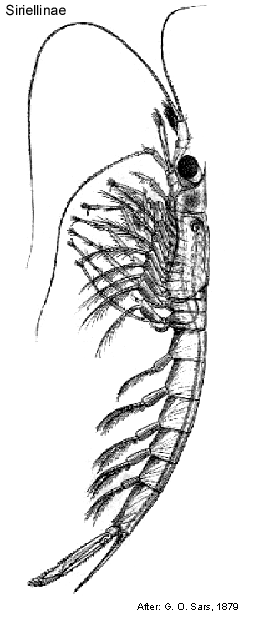 |
||||||
|
|
|
|
|
|
Mysidacea: Families, Subfamilies and TribesKenneth MelandSiriellinae Norman, 1892 Diagnostic description. Head. Carapace short, last 2 or 3 thoracic somites exposed dorsally. Rostrum obtuse, or elongated. Eyes normally developed. Antenna (antenna 2) scale with apical suture, outer margin smooth, without setae, with terminal spine. Labrum produced anteriorly. Mandible lacinia mobilis well developed, spine row present between lacinia mobilis and molar process, molar process reduced. Thorax. 1st maxilliped exopod well developed. 2nd thoracopod developed as a maxilliped, exopod well developed. 3rd-8th thoracopods endopod with distinct carpus and propodus, propodus unsegmented or propodus divided into two segments. Branchiae on thoracopods absent. Marsupium composed of three pairs of oostegites. Abdomen 6th & 7th abdominal somites fused. 1st pair biramous, or endopod reduced (as in Siriella armata); 2nd pair biramous; 3rd pair biramous; 4th pair biramous; 5th pair biramous. Female pleopods uniramous or greatly reduced. Uropod endopod inner margin with robust setae, statocyst present; exopod with distal articulation, outer margin with robust setae. Telson apex entire. Generic composition. Siriellinae contains 3 genera (67 species): Tribe Siriellini Hemisiriella Hansen, 1910 (4 species); Siriella Dana, 1850 (62 species) and Tribe Metasiriellini Metasiriella kitaroi Murano, 1986. Remarks. The Siriellinae are cosmopolitan shallow water mysids inhabiting the littoral and coastal zones. These mysids are easily recognized by by the third to eighth pereiopods armed with very strong nails surrounded by a stiff brush of long setae and the male pleopods supporting conspicuous coiled or curved pseudobranchiae. In establishing the monotypic genus Metasiriella Murano, 1986 the Siriellinae where divided into two tribes. The tribe Siriellini contains Hemisiriella Hansen, 1910 and Siriella Dana, 1850 and diagnosed by the male pleopods with a spirally coiled or straight pseudobranchial lobe on the basal segment of the endopod. The tribe Metasiriellini consists of the species Metasiriella kitaroi Murano, 1986 and is diagnosed by the reduction of the first, second, third, and fifth male pleopods, and a fourth biramous pleopod with a uniramous and pseudobranchial lobe on the basal segment of the endopod.
Cite this publication as: 'Meland, K. (2002 onwards). Mysidacea: Families, Subfamilies and Tribes. Version 1: 2 October 2002. https://crustacea.net'. |
|
|
|
|
|
|
|
|
|
Copyright © Australian Museum, 2002 - 2003
Australian Museum website
